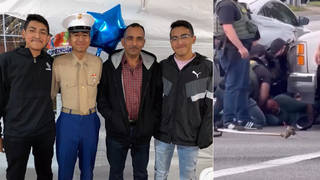
Guests
- Shane Baueraward-winning senior reporter at Mother Jones. His report, “Undercover with a Border Militia,” was funded in part by the Puffin Foundation.
Mother Jones senior reporter Shane Bauer joins us to describe how he went undercover to report on America’s right-wing militia movement and what he found. Using Facebook, he joined the III% United Patriots militia, which operates in more than a dozen states. He then traveled to the U.S.-Mexico border to join the militia on a citizen vigilante mission aimed at catching undocumented immigrants. Wearing a hidden camera, he captured collaboration between the paramilitary groups and the U.S. Border Patrol. “Right now we have 270 militias across the country,” Bauer notes. “A lot of states have laws that ban militia training or paramilitary training. There have been no cases of these laws being enforced.”
Transcript
NERMEEN SHAIKH: We turn now to a stunning new exposé for Mother Jones magazine looking at America’s resurgent paramilitary movement.
SHANE BAUER: We have, throughout the country, groups of armed men, mostly white men, that see themselves as a defense against the federal government.
ERIC SHAWN: Armed protesters are vowing to occupy a federal building in Oregon for as long as it takes.
TONY DOKOUPIL: Three members of a right-wing militia were arrested.
RACHEL MADDOW: Armed supporters pointing guns at federal law enforcement officers.
SHANE BAUER: A lot of these militias were born, basically, after Obama got elected. The initial movement in the ’90s died down after George Bush was elected, and as soon as we elected the first black president, membership skyrocketed.
NERMEEN SHAIKH: Mother Jones senior reporter Shane Bauer went undercover to report on a right-wing militia movement. Using Facebook, he joined the III% United Patriots militia, which operates in more than a dozen states. Bauer traveled to the U.S.-Mexico border to join the militia on Operation Spring Break, a citizen vigilante mission aimed at catching undocumented immigrants. In a video accompanying the piece, Bauer explains how he landed the job using his own name and personal information, despite his years as an award-winning journalist.
SHANE BAUER: When I set up my Facebook page and whenever I reached out to these guys, I used my real name. Had they googled me, they would have seen that I was a senior reporter at Mother Jones, and they probably would not have allowed me into their organization. …
There’s armed guards at the base, guys with AR-15s kind of patrolling it. I just kind of rolled up, had my camo on. They didn’t really ask any questions. These guys were really amped up. And a lot of them were military veterans that had served in Iraq and Afghanistan. I was always worried when I was out on these things that we’re going to actually run into somebody. My understanding was that if we did run into somebody, we were to call the base, and the base would call the Border Patrol. We’re not supposed to shoot anybody, unless somebody shoots at us. But when we’re going out on these operations, guys are talking about hunting Mexicans. I mean, the stuff they’re saying is like—it doesn’t—it’s not hard to imagine a situation in which they’re shooting somebody.
AMY GOODMAN: Well, for more, we’re going to Berkeley, California. Shane Bauer joins us to discuss this exposé. It’s headlined “Undercover with a Border Militia.” It was funded in part by the Puffin Foundation.
Shane, welcome back to Democracy Now! Explain exactly where you went and who these people were.
SHANE BAUER: Thanks for having me, Amy. I, initially, actually, joined a couple of militias in California and was training with them for several months, but my main interest was on a kind of new phenomenon of nationally organized militias. The III% United Patriots is probably the largest of these groups. And I saw that they were having an operation on the border, so I traveled down to the border.
AMY GOODMAN: And explain that name, the 3 percent.
SHANE BAUER: Yeah, they’re part—the III% United Patriots are part of a larger movement that calls itself the Three Percenter movement. This movement was born after Obama’s election. And they believe that the American Revolution was won by 3 percent of the population. And the idea is that if they can get 3 percent of the population behind them, then they can restore the Bill of Rights. That’s kind of how they look at their work.
NERMEEN SHAIKH: And do these paramilitary organizations tend to have a disproportionate number of military veterans? And if so, Shane Bauer, why do you think that is?
SHANE BAUER: You know, it varies from group to group. The Three Percenter groups, in particular, do have a lot of military veterans. When I was on this border operation, I had—you know, one military Marine veteran told me that he considered this therapy. He said it reminded him a lot of Afghanistan. And I had heard from a number of these guys that when they left the military, they missed the kind of sense of camaraderie that they found in the military. I kind of had the sense that they came back home and didn’t find what they had hoped, and they had felt somewhat alienated. And in the militia, they kind of, you know, have a—get a sense of what they had in the military. A lot of these guys also seemed to be pretty disillusioned with the military leadership and had a sense of loyalty to their former soldiers, but were generally very skeptical and frustrated with the federal government itself.
AMY GOODMAN: So, talk about where you went. But first I want to play this video clip that accompanies your report at Mother Jones, together with Fusion, the militia group unexpectedly meeting up with U.S. Border Patrol in the dark, after a few tense moments, recognizing one another. This is a Border Patrol agent, who identifies himself as an intelligence officer, speaking to the militia after the encounter, followed by your commentary.
BORDER PATROL AGENT: [inaudible] give you a heads-up next time you guys are going to come down? If you want to come—if you plan on coming down to the Nogales area, since you’re out in Cal—or Colorado, hitch a ride, take a trip out there, maybe give you guys an unauthorized brief.
MILITIA MEMBER: All right.
BORDER PATROL AGENT: So, you didn’t hear none of that [bleep] from me.
SHANE BAUER: I was really surprised to see how much the Border Patrol was cooperating with these guys—
BORDER PATROL AGENT: And then, when you all get down here, I’ll link up with you again.
SHANE BAUER: —to see—kind of be inside that world and see the ways that these guys are talking about hunting Mexicans and that kind of stuff—
MILITIA MEMBER: That’s what you’ve got to carry. It’s [bleep] light.
SHANE BAUER: —and then to see federal law enforcement not only tolerate them, but kind of use them in a certain way.
BORDER PATROL AGENT: I love having y’all out here, man. Like I said before, it impresses me that you guys come out to do my job for me for no pay at all.
AMY GOODMAN: Wow, so there you have it, Shane. That was a Border Patrol agent saying, “It impresses me that you’re coming here to do my job for no pay at all.” Talk about what they were doing together, what the Border Patrol told them to do—for example, if they see water in the desert, bottles of water that perhaps were left for migrants, to dump it?
SHANE BAUER: Yeah. So, we were out in near Nogales, Arizona, about an hour from Nogales, way out in the middle of the desert, I mean, pretty much as remote as you can get. And I saw many interactions between the militia and the Border Patrol. The Border Patrol would come to the militia base, sometimes bring us doughnuts. And in this particular case, when we saw this man who said that he was an intelligence officer, he was directing us where to set up to find people crossing the border. He actually took us to show us the exact locations where they said that we should set up.
And I later—before publishing this story, I reached out to the leadership of the III% United Patriots, who I was with on the border, and I spoke to the leader, Mike Morris, and I asked him about his relationship with the Border Patrol. He said that he was still, now that he’s back in Colorado, was in contact with the Border Patrol on a weekly basis, and that whenever they set up an operation, they talk to the Border Patrol, and the Border Patrol will tell them when to come down and where to set up. In that particular interaction, the Border Patrol was telling us to destroy food and water that we found in the desert. And I saw that happen out in the desert.
NERMEEN SHAIKH: Shane Bauer, could you talk about how militia members receive training, and by whom and what kind of training? One person you spoke to, Showtime, told you that waterboarding and tasing are part of their training. So could you say a little about that?
SHANE BAUER: Yeah, so, right now we have more than 270 militias across the country, according to the Southern Poverty Law Center. These militias, you know, most of them are not doing these kind of border operations but are more kind of regionally focused. But, you know, a core part of being in a militia is doing this kind of paramilitary training. So, there—you know, guys get together at least once a month, sometimes every week, depending on the group, and do kind of small group infantry-type training.
The III% United Patriots, in particular, also have—they have their own kind of special forces within the militia. And they described to me, when I was in Arizona, some of that training, which involves a kind of 36-hour-long stretch where new members, new recruits, are put in a scenario where they’re told that they have been captured by a border cartel. They are sleep-deprived for 36 hours. They’re waterboarded. They described putting people in what they call stress boxes, and naked except for a T-shirt out in the Colorado winter, and are tased and sometimes cattle-prodded through holes in the box. They even described one instance in which a man, who they were doing this mock interrogation with, wouldn’t speak, and they brought in a female member of the militia and said if he wouldn’t speak, they would tase her. And the man who told me this story said that he proceeded to tase this woman and then cattle-prod her.
AMY GOODMAN: Can you talk—
SHANE BAUER: And I also witnessed them—I mean, they told the Border Patrol also about these trainings and kind of were boasting about it. And Border—this intelligence officer of the Border Patrol was just kind of laughing.
AMY GOODMAN: Talk about the legality of these militias and all the states that they’re operating in, how heavily armed people are.
SHANE BAUER: So, these militias, they call themselves militias because they’re associating themselves with the militia of the Revolutionary War and the kind of period after the Revolutionary War. And there have been laws that have carried over and stay on the books from that time, a time when states and the federal government were requiring every white male to be a part of the militia. They are essentially, you know, pointing to these old laws and saying that we are this militia. The issue is that a lot of states have laws that ban militia training or paramilitary training. These laws have never—there have been no cases of these laws being enforced.
NERMEEN SHAIKH: Well, earlier this month—I want to ask about another militia—three members of a Kansas militia, known as the Crusaders, were arrested for plotting to blow up an apartment complex in Kansas that is home to many Somali refugees and houses a mosque. All three militia members were white men in their late forties. According to the FBI, the militia supported anti-Muslim, anti-immigrant and anti-government beliefs. Shane Bauer, could you say whether you think that’s representative of most militia groups? Who are they fighting against in addition to the federal government?
SHANE BAUER: Look, these militias and their members are—all have kind of different motives. The kind of common thread is that they see themselves as a defense against what they call the tyranny of the federal government. Many of them would also say their primary focus is to prepare for disasters, whether it be a natural disaster or, you know, kind of civil unrest. A lot of them will talk about Black Lives Matter. They talk a lot about Islamic terrorism. And, you know, they will say that they are not racist. They are not white supremacists in the sense that we think of. However, it is very common to hear and to see in social media anti-Muslim rhetoric and anti-immigrant rhetoric.
You know, I think most militias would distance themselves from the act that you just described. Many of them actually distance themselves from what happened in Burns, Oregon, recently. But there are a pretty large number of cases in the past five or 10 years of militia factions kind of going off and planning terrorist attacks. Many have been thwarted by the FBI. There have also been—there also was a case not very long ago in Georgia of a militia killing three people. A militia leader killed his wife for life insurance money and put that money into buying arms for his militia. And he ended—two members of the militia ended up killing two people that they believed knew too much. So, you know, the movement is very fractured, and there ends up being kind of small groups that, you know, are very isolated. And, you know, there is a risk of these smaller groups kind of going off on their own.
AMY GOODMAN: Shane, we have to leave it there, but it is a fascinating investigation, undercover operation. Shane Bauer, award-winning senior reporter at Mother Jones. We’ll link to your piece, “Undercover with a Border Militia.”
And that does it for the show. I’ll be speaking tonight at Arizona, Tempe, Arizona, at Arizona State University, Carson Ballroom, 7:00 p.m. Check our website.












Media Options